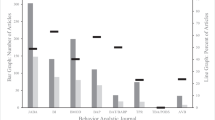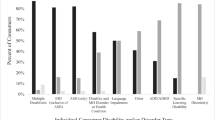Abstract
Since its inception in the mid-1970s, social validity has provided applied behavior analysts with a critical measure of the social impact and importance of their interventions. Recent discussion, however, has questioned the use of this construct in regard to the frequency and types of social validity measures employed in research. Despite the ensuing discussion, virtually no quantitative information has been made available to frame various perspectives and opinions. The purpose of this report is to present a content analysis of social validity measures used over the previous 20 years. Social validity was assessed along three dimensions: (a) type of assessment, (b) focus of assessment, and (c) time of assessment. Articles published in the Journal of Applied Behavior Analysis (1968–1990) and Behavior Modification (1977–1990) were surveyed. The results of the content analysis indicate that current applications of social validation procedures are presented in 20% of the articles surveyed, The majority of articles used subjective evaluation of outcomes following intervention to assess social validity. In addition, the data indicated that normative comparison was a rarely used method of social validation and that its use has been decreasing over time.
Similar content being viewed by others
References
Baer, D. M. (1974). On the absence of Santa Claus in any known eco-system. Journal of Applied behavior Analysis, 7, 167–171.
Baer, D. M. (1986). In application, frequency is not the only estimate of the probability of behavior units. In T. Thompson & M. D. Zeiler (Eds.), Analysis and integration of behavioral units (pp. 117–136). Hillsdale, NJ: Lawrence Erlbaum.
Baer, D. M., Wolf, M. M., & Risley, T. R. (1987). Some still-current dimensions of applied behavior analysis. Journal of Applied Behavior Analysis, 20, 313–327.
Barahal, D. G., Bramer, L. M., & Shostrom, E. L. (1950). A client-centered approach to education-vocational counseling. Journal of Consulting Psychology, 14, 256–260.
Barlow, D. H. (1981). On the relation of clinical research to clinical practice: Current issues, new directions. Journal of Consulting and Clinical Psychology, 49, 147–159.
Bordin, E. S. (1955). The implications of client expectations for the counseling process. Journal of Counseling Psychology, 2, 17–21.
Bornstein, P. H., & Rychtarik, R. G. (1983). Consumer satisfaction in adult behavior therapy: Procedures, problems, and future perspectives. Behavior Therapy, 14, 191–208.
Brigham, T. A., Graubard, P. S., & Stans, A. (1972). Analysis of the effects of sequential reinforcement contingencies on aspects of composition. Journal of Applied Behavior Analysis, 5, 421–434.
Briscoe, R. V., Hoffman, D. B., & Bailey, J. S. (1975). Behavioral community psychology: Training a community board to problem solve. Journal of Applied Behavior Analysis, 8, 157–165.
Brookes, P. H., & Baumeister, A. A. (1977). A plea for consideration of ecological validity in the experimental psychology of mental retardation. American Journal of Mental Deficiency, 81, 407–416.
Charlop, M. H., & Milstein, J. P. (1989). Teaching autistic children conversational speech using video modeling. Journal of Applied Behavior Analysis, 22, 275–285.
Clark, H. B., Greene, B. F., Macrea, J. W., McNees, M. P., Davis, J. L., & Risley, T. R. (1977). A parent training package for family shopping trips: Development and evaluation. Journal of Applied Behavior Analysis, 10, 605–624.
Elliot, S. N., Witt, J. C., Galvin, G. E., & Moe, G. L. (1986). Children’s involvement in intervention selection: Acceptability of interventions for misbehaving peers. Professional Psychology: Research and Practice, 17, 235–241.
Fawcett, S. B. (1991). Social validity: A note on methodology. Journal of Applied Behavior Analysis, 24, 235–240.
Fawcett, S. B., & Miller, K. L. (1975). Training public speaking behavior: An experimental analysis and social validation. Journal of Applied Behavior Analysis, 8, 125–141.
Friman, P. C., Finney, J. W., Rapoff, M. A., & Christophersen, E. R. (1985). Improving pediatric appointment keeping with reminders and reduced response requirement. Journal of Applied Behavior Analysis, 18, 315–321.
Gaylord-Ross, R. J. (1979). Mental retardation research, ecological validity, and the delivery of longitudinal educational programs. Journal of Special Education, 13, 69–80.
Goode, W. F., & Fowler, I. (1949). Incentive factor in a low morale plant. American Sociological Review, 14, 79–93.
Grant, C. W. (1954). How students perceive the counselor’s role. Personnel and Guidance Journal, 38, 386–394.
Green, R. B., Hardison, W. L., & Greene, B. F. (1984). Turning the table on advice programs for parents: Using placemats to enhance family interaction at restaurants. Journal of Applied Behavior Analysis, 17, 497–507.
Gullone, E., & King, N. J. (1989). Acceptability of behavioral interventions: Child and caregiver perceptions. In M. Hersen, R. M. Eisler, & P. M. Miller (Eds.), Progress in behavior modification (Vol. 24, pp. 132–151). Newbury Park, CA: Sage.
Haring, T. G., & Kennedy, C. H. (1990). Contextual control of problem behavior in students with severe disabilities. Journal of Applied Behavior Analysis, 23, 235–243.
Hawkins, R. P. (1975). Who decided that was the problem? Two stages of responsibility for applied behavior analysts. In W. S. Wood (Ed.), Issues in evaluating behavior modification (pp. 195–214). Champaign, IL: Research Press.
Hawkins, R. P. (1991). Is social validity what we are interested in? Argument for a functional approach. Journal of Applied Behavior Analysis, 24, 205–213.
Herzberg, F., Mausner, B., & Syndern, B. B. (1959). The motivation to work. New York: John Wiley & Sons.
Horner, R. H., & Day, H. M. (1991). The effects of response efficiency on functionally equivalent competing behaviors. Journal of Applied Behavior Analysis, 24, 719–732.
Kazdin, A. E. (1977). Assessing the clinical or applied significance of behavior change through social validation. Behavior Modification, 1, 427–452.
Kazdin, A. E. (1978). History of behavior modification: Experimental foundations of contemporary research. Baltimore, MD: University Park Press.
Kazdin, A. E. (1980). Acceptability of alternative treatments for deviant child behavior. Journal of Applied Behavior Analysis, 13, 259–273.
Kazdin, A. E., & Wilson, G. T. (1978). Criteria for evaluating psychotherapy. Archives of General Psychiatry, 35, 407–416.
Koos, E. L. (1955). “Metropolis”–What city people think of their medical services. American Journal of Public Health, 45, 1551–1557.
Lebow, J. L. (1982). Consumer satisfaction with mental health treatment. Psychological Bulletin, 91, 244–259.
Lovitt, T. C. (1978). New applications and new techniques in behavior modification. Journal of Special Education, 12, 89–93.
Mace, F. C., McCurdy, B., & Quigley, E. A. (1990). A collateral effect of reward predicted by matching theory. Journal of Applied Behavior Analysis, 23, 197–206.
Makeover, H. B. (1950). The quality of medical care. American Journal of Public Health, 41, 824–832
Maloney, K. B., & Hopkins, B. L. (1973). The modification of sentence structure and its relationship to subjective judgments of creativity in writing. Journal of Applied Behavior Analysis, 6, 425–441.
McMahon, R. J. (1983). Consumer satisfaction in behavioral treatment of children: Types, issues, and recommendations. Behavior Therapy, 14, 209–225.
Nutter, D., & Reid, D. H. (1978). Teaching retarded women a clothing selection skill using community norms. Journal of Applied Behavior Analysis, 11, 457–487.
O’Brien, F., & Azrin, N. H. (1972). Developing proper mealtime behaviors of the institutionalized retarded. Journal of Applied Behavior Analysis, 5, 389–396.
Phillips, E. L., Wolf, M. M.,& Fixsen, D. L. (1973). Achievement Place: Development of the elected manager system. Journal of Applied Behavior Analysis, 6, 541–554.
Roethlisberger, F. J., & Dickson, W. J. (1939). Management and the worker. Cambridge, MA: Harvard University Press.
Rogers, C. R. (1942). Counseling and psychotherapy: New concepts in practice. New York: Houghton Mifflin Company.
Rogers-Warren, A., & Warren, S. F. (1977). Ecological perspectives in applied behavior analysis. Baltimore, MD: University Park Press.
Schwartz, I. S., & Baer, D. M. (1991). Social validity assessments: Is current practice state of the art? Journal of Applied Behavior Analysis, 24, 189–103.
Scott, M. (1980). Ecological theory and methods for research in special education. Journal of Special Education, 14, 279–294.
Singh, N. N., & Katz, R. C. (1985). On the modification of acceptability ratings for alternative child treatments. Behavior Modification, 9, 375–386.
Skinner, B. F. (1956). A case history in scientific method. American Psychologist, 11, 221–233.
Stevenson, H. C., & Fantuzzo, J. W. (1986). The generality and social validity of a competency-based self-control training intervention for underachieving students. Journal of Applied Behavior Analysis, 19, 269–275.
Van Houten, R. (1979). Social validation: The evolution of standards of competency for target behaviors. Journal of Applied Behavior Analysis, 12, 581–591.
Van Houten, R., Morrison, E., Jarvis, R., & Mac-Donald, M. (1974). The effects of explicit timing and feedback on compositional response rate in elementary school children. Journal of Applied Behavior Analysis, 7, 547–554.
Wacker, D. P., Steege, M. W., Northup, J., Sasso, G., Berg, W., Reimers, T., Cooper, L., Cigrand, K., & Donn, L. (1990). A component analysis of functional communication training across three topographies of severe behavior problems. Journal of Applied Behavior Analysis, 23, 417–430.
Wienerman, E. R. (1964). Patients’ perceptions of group medical care: A review and analysis of studies on choice and utilization of prepaid group practice plans. Group Medical Care, 54, 880–889.
Willems, E. P. (1974). Behavioral technology and behavioral ecology. Journal of Applied Behavior Analysis, 7, 151–165.
Winett, R. A., Moore, J. F., & Anderson, E. S. (1991). Extending the concept of social validity: Behavior analysis for disease prevention and health promotion. Journal of Applied Behavior Analysis, 24, 215–230.
Wolf, M. M. (1978). Social validity: The case for subjective measurement or how applied behavior analysis is finding its heart. Journal of Applied Behavior Analysis, 11, 203–214.
Yeaton, W. H., & Sechrest, L. (1981). Critical dimensions in the choice and maintenance of successful treatments: Strengths, integrity, and effectiveness. Journal of Consulting and Clinical Psychology, 49, 156–167.
Author information
Authors and Affiliations
Rights and permissions
About this article
Cite this article
Kennedy, C.H. Trends in the Measurement of Social Validity. BEHAV ANALYST 15, 147–156 (1992). https://doi.org/10.1007/BF03392597
Published:
Issue Date:
DOI: https://doi.org/10.1007/BF03392597




